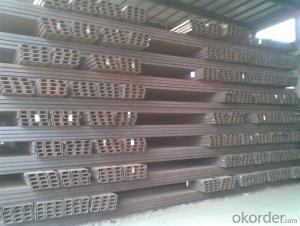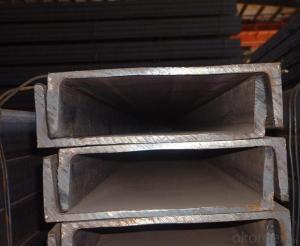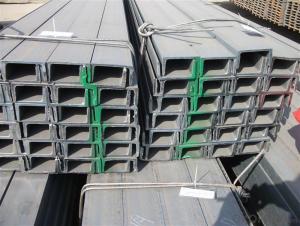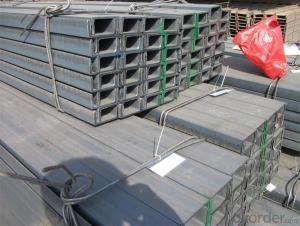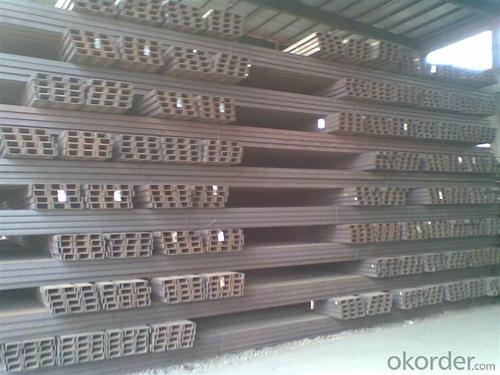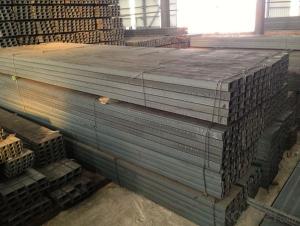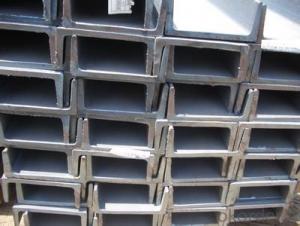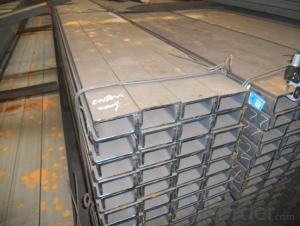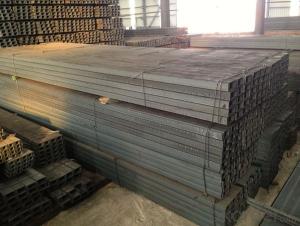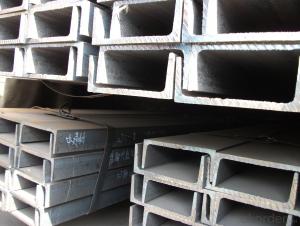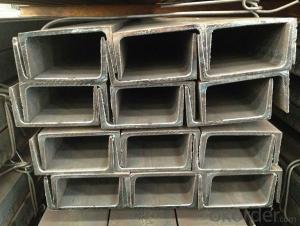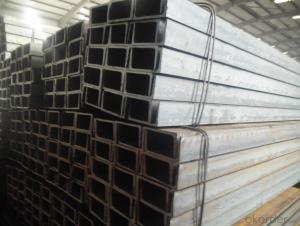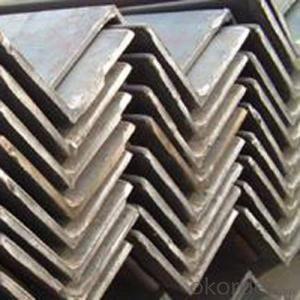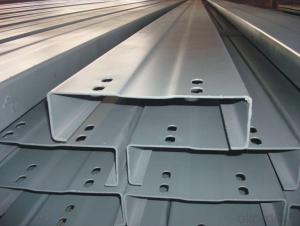Hot Rolled Mild JIS Standard Steel U Channels for Warehouses
- Loading Port:
- Tianjin
- Payment Terms:
- TT or LC
- Min Order Qty:
- 50 m.t.
- Supply Capability:
- 10000 m.t./month
OKorder Service Pledge
OKorder Financial Service
You Might Also Like
Product Description:
Hot Rolled Mild JIS Standard Steel U Channels for Warehouses:
1.Our UPN Channel Steel has lots of advantages, just as followings:
a) At reasonable price and good quality.
b) To be convenient in construction and to save much time and labor.
c) The length of UPN can be manufactured according to customer’s requirements.
d) The UPN Channel Steel has strong mechanical strength.
e). The UPN Channel Steel possesses various kind of fittings, through which it is suitbal for many combinations.
f) Our UPN Channel Steel is attractive in appearance as well as beautiful in design
g) Free from slotted punching
2. The detailed sections of our UPN Channel Steel can be found in table-1
UPN U CHANNEL | Standard h | Sectional b | Dimension s | t | Mass: Kg/m |
| (mm) | (mm) | (mm) | (mm) |
|
80x45 | 80 | 45 | 6.0 | 8.0 | 8.64 |
100X50 | 100 | 50 | 6.0 | 8.5 | 10.6 |
120x55 | 120 | 55 | 7.0 | 9.0 | 13.4 |
140x60 | 140 | 50 | 7.0 | 10.0 | 16.0 |
160x65 | 160 | 65 | 7.5 | 10.0 | 18.8 |
180x70 | 180 | 70 | 8.0 | 11.0 | 22.0 |
Table-1
Note: we are definitely good at manufacturing and supplying UPN channel steel as per S235JR. Also, we are willing and able to provide our customers UPN channel steel in other sizes, which depends on customers’ concret requirements for the quantity.
3. The chemical composition of UPN Channel Steel as per S235JR is shown in the table-2
Alloy No | Element(%) | ||||
C | Mn | S | P | Si | |
S235JR | 0.12—0.20 | 0.3—0.7 | ≤0.030 | ≤0.030 | ≤0.20 |
Table-2
4. The mechanical property of UPN Channel Steel as per S235JR is shown in the table-3-1 and table-3-2
Alloy No | Yielding strength point( Mpa) | |||
Thickness (mm) | ||||
≤16 | >16--40 | >40--60 | >60--100 | |
≥ | ||||
S235JR | 235 | 225 | 215 | 195 |
Table-3-1
Alloy No | Tensile strength (Mpa) | Elongation after fracture(%) | |||
Thickness (mm) | |||||
| ≤16 | >16--40 | >40--60 | >60--100 | |
≥ | |||||
S235JR | 340--510 | 24 | 23 | 22 | 27 |
Table-3-2
Applications of Hot Rolled Mild JIS Standard Steel U Channels for Warehouses:
The UPN Channel Steel can be applied to construction of warehouses, workshops, sport stadiums and car parks etc.The hot rolled channel steel belongs to carbon structural steel which is applied to in the field of construction and machinery.In details, the hot rolled channel steel is usually used for arch-itechtural structure, and they could be welded in order to support or hang a vari-ety of facilities. They are also usually used in combination with I beam. Generally,the hot rolled channel steel we supply must possess perfect welding property, riveting property and mechanical property and so on.
Package & Delivery of Hot Rolled Mild JIS Standard Steel U Channels for Warehouses:
1.The channel steel will be packed in bundle with steel wire at each end of every bundle and color marking in order to help the customer to recognize his goods more easily at sight.
2. And the channel steel could be loaded into 20ft or 40ft container, or by bulk cargo.If the weight of each bundle reaches more than 3.5 mt, the loading by break bulk cargo should be choosed.When the weight of each bundle reaches less than 3mt, the loading by container should be choosed.
3.As for the transportaion from mill to loading port, the truck will be usually used. And the maximum quantity for each truck is 40mt.
4.All in all, we could do in accordance with customer's request.
Production Flow of Hot Rolled Mild JIS Standard Steel U Channels for Warehouses:
1.The steel billet shall be heated in the high temperature furnace.
2. The heated steel billet shall be rolled five to nine times with the aim of shaping the general figure of steel u channel.
3. The rolled steel u channel should be put onto the cooling bed to make the temperature low.
4. The steel u channel should be straighted on the straightener.
5. The straighted steel u channel will be cut into meters by saw, as per customer's requirements.
6. At the last part of production, the channel steel must be tested in order to confirm that the finished products are completely free from crack, pore, slag, scab or fold on the surface.
FAQ:
Q1: How soon can we receive the product after purchase?
A1: Within three days of placing an order, we will begin production. The specific shipping date is dependent upon international and government factors, but is typically 7 to 10 workdays.
Q2: What makes stainless steel stainless?
A2: Stainless steel must contain at least 10.5 % chromium. It is this element that reacts with the oxygen in the air to form a complex chrome-oxide surface layer that is invisible but strong enough to prevent further oxygen from "staining" (rusting) the surface. Higher levels of chromium and the addition of other alloying elements such as nickel and molybdenum enhance this surface layer and improve the corrosion resistance of the stainless material.
Q3: Can stainless steel rust?
A3: Stainless does not "rust" as you think of regular steel rusting with a red oxide on the surface that flakes off. If you see red rust it is probably due to some iron particles that have contaminated the surface of the stainless steel and it is these iron particles that are rusting. Look at the source of the rusting and see if you can remove it from the surface.
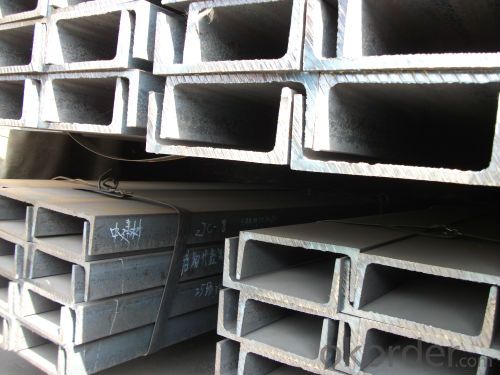
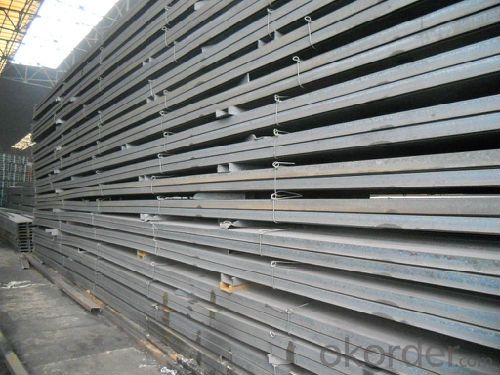
- Q: How do steel channels compare to timber or concrete channels?
- Steel channels have numerous advantages over timber or concrete channels. Firstly, they possess greater strength and durability in comparison to timber channels. With a higher load-bearing capacity, steel channels can withstand heavy loads without warping or bending. This attribute makes them exceptionally well-suited for applications where strength and durability are essential, such as construction projects or industrial settings. Secondly, steel channels exhibit more resistance to environmental factors such as moisture, rot, and pests, which can significantly impact timber channels. Unlike timber channels, steel channels do not require regular maintenance, potentially eliminating the need for treatments or replacements over time. Additionally, steel channels offer enhanced design flexibility when compared to timber or concrete channels. They can be easily fabricated and customized to fit specific dimensions and requirements, making them suitable for a wide range of construction and engineering projects. Furthermore, steel channels possess a longer lifespan than timber or concrete channels. They are not prone to decay or degradation, ensuring that they will endure for many years without the need for replacement. This longevity can result in cost savings in the long run, as there is no necessity for frequent repairs or replacements. In conclusion, steel channels deliver superior strength, durability, resistance to environmental factors, and design flexibility in comparison to timber or concrete channels. They are a reliable and efficient choice for various construction and engineering applications.
- Q: How do steel channels contribute to the overall energy efficiency of a building?
- Steel channels can contribute to the overall energy efficiency of a building in several ways. Firstly, they offer structural support, allowing for the construction of taller and larger buildings with less material, reducing overall energy consumption during the construction phase. Additionally, steel channels are often used for insulation purposes, acting as thermal barriers to minimize heat transfer and improve the building's insulation efficiency. Furthermore, steel channels can be designed to accommodate wiring and plumbing systems, optimizing space utilization and reducing energy losses associated with long wire or pipe runs. Overall, steel channels play a crucial role in enhancing the energy efficiency of a building by providing strength, insulation, and efficient utility distribution.
- Q: Can steel channels be used in signage applications?
- Yes, steel channels can be used in signage applications. They provide durability, stability, and a sleek appearance, making them suitable for outdoor and indoor signage installations. Additionally, steel channels can be easily customized and fabricated to meet specific design requirements, making them a versatile choice for signage applications.
- Q: What are the different design considerations for steel channels in industrial buildings?
- Several important factors must be considered when designing steel channels for industrial buildings. Firstly, it is crucial to assess the load capacity of the channels. This involves calculating the maximum expected loads that the channels will need to support, such as the weight of machinery, equipment, or materials. It is necessary to design the channels with sufficient strength and stiffness to handle these loads without excessive deflection or deformation. Another significant consideration is the structural stability of the channels. The design must ensure that the channels are capable of resisting lateral forces, such as wind or seismic loads, without buckling or collapsing. This may require connecting or bracing the channels to other structural elements in order to provide the necessary stability. Additionally, the durability of the steel channels is a key concern. Industrial environments can be harsh, with exposure to moisture, chemicals, and other corrosive substances. Therefore, the channels must be designed to withstand these conditions and resist corrosion. This may involve the use of protective coatings or stainless steel materials. The ease of fabrication and installation is another factor that needs to be taken into account. The design should aim to minimize the complexity and time required for fabrication and construction. This can be achieved by using standard steel channel sizes and connections, as well as designing with efficient assembly methods in mind. Fire safety is also a crucial consideration in industrial buildings. Steel channels should be designed to have adequate fire resistance, either through the use of fireproof coatings or by incorporating fireproofing materials such as gypsum board. Finally, depending on the specific requirements of the industrial building, the aesthetic appearance of the steel channels may also be a consideration. While functionality and safety are of primary importance, the design may also need to consider the visual impact and architectural integration of the channels within the building. In conclusion, the design considerations for steel channels in industrial buildings include load capacity, structural stability, durability, ease of fabrication and installation, fire safety, and aesthetics. By carefully addressing these factors, the design can ensure the safe and efficient use of steel channels in industrial buildings.
- Q: How do steel channels contribute to the stability of a structure during hurricanes?
- Steel channels contribute to the stability of a structure during hurricanes in several ways. Firstly, steel channels are known for their high strength and load-bearing capacity. They are widely used in the construction industry to provide structural support and reinforcement. During hurricanes, when strong winds and intense forces are exerted on a building, steel channels help distribute these forces evenly throughout the structure. This prevents concentrated stress points and reduces the likelihood of structural failure. Moreover, steel channels are often incorporated into the framing of walls, roofs, and floors of a building. These channels create a rigid framework that enhances the overall stability of the structure. This rigidity helps the building withstand the lateral forces and uplift pressures generated by hurricane winds. By resisting these forces, steel channels minimize the risk of the structure collapsing or being severely damaged during a hurricane. Additionally, steel channels can be strategically placed in critical locations within a building to reinforce specific areas that are prone to wind and storm damage. For example, they can be used to strengthen window and door openings, which are vulnerable to wind pressure. By installing steel channels around these openings, the structure becomes more resistant to the uplift and inward forces caused by high-speed winds, reducing the likelihood of these openings being blown out or compromised. Furthermore, steel channels are highly durable and resistant to corrosion, making them ideal for withstanding the harsh environmental conditions associated with hurricanes. Unlike other construction materials, steel channels do not deteriorate or weaken when exposed to moisture, saltwater, or high humidity levels. This longevity ensures that the structural integrity of the building remains intact, even after multiple hurricane events. In summary, steel channels play a crucial role in enhancing the stability of a structure during hurricanes. Their high strength, load-bearing capacity, rigidity, and resistance to environmental conditions make them an essential component in the construction of hurricane-resistant buildings. By effectively distributing forces, reinforcing critical areas, and maintaining their structural integrity, steel channels help protect structures and their occupants from the destructive forces of hurricanes.
- Q: No. 8 at No. 6 steel, how much is the channel size
- The dimensions are eighty cm and sixty cm
- Q: Can steel channels be used in mezzanine construction?
- Certainly! Mezzanine construction can certainly benefit from the usage of steel channels. These channels are widely employed in the construction of buildings due to their exceptional strength and longevity. Mezzanines, which are intermediate floors inserted between a building's primary floors, enhance the available space and functionality. To ensure stability and support for the structure, steel channels can be utilized as either beams or columns in mezzanine construction. Their fabrication and installation are hassle-free, rendering them an optimal choice for mezzanine construction projects. Furthermore, steel channels can be tailor-made to meet specific design requirements and can be combined with other steel components like plates and angles, resulting in a sturdy and dependable mezzanine structure.
- Q: What are the different load distribution methods for steel channels in bridges?
- There are several different load distribution methods for steel channels in bridges that are commonly used in engineering design. These methods help distribute the loads and stresses effectively to ensure the structural integrity and safety of the bridge. 1. Equal Distribution Method: This is the simplest load distribution method where the load is distributed equally among all the steel channels in the bridge. Each channel carries an equal share of the load, resulting in uniform stress distribution. 2. Elastic Load Distribution Method: In this method, the load is distributed based on the elastic properties of the steel channels. The load is distributed in proportion to the stiffness of each channel, considering factors such as the moment of inertia and modulus of elasticity. This method ensures that the channels with higher stiffness carry a larger portion of the load. 3. Influence Line Method: The influence line method is a graphical technique used to determine the distribution of loads on steel channels. It involves analyzing the effects of a moving load on the bridge structure. By plotting the influence lines for different positions of the load, engineers can identify the channels that experience the highest stresses and adjust the load distribution accordingly. 4. Finite Element Analysis (FEA): FEA is a numerical method used to analyze complex structures, including bridges. By dividing the bridge into small elements and solving the governing equations, FEA can simulate the behavior of the structure under different loading conditions. This method allows for accurate load distribution calculations by considering various factors like the geometry, material properties, and boundary conditions of the bridge. 5. Design Codes and Standards: Many countries have specific design codes and standards that provide guidelines for load distribution in bridge design. These codes take into account factors such as the type of bridge, span length, traffic loads, and environmental conditions. By following these codes, engineers can ensure that the load distribution methods used in steel channel bridges meet the safety requirements. It is important to note that the selection of the appropriate load distribution method depends on various factors, including the bridge's design, expected loads, and the desired level of safety. Engineers must carefully consider these factors and use appropriate methods to ensure optimal load distribution and structural performance of steel channel bridges.
- Q: How are steel channels resistant to corrosion?
- Due to the presence of a protective oxide layer on their surface, steel channels exhibit resistance to corrosion. This oxide layer is naturally formed through a process known as passivation, wherein exposure to oxygen in the air results in the creation of a thin layer of chromium oxide on the steel's surface. Acting as a barrier, this oxide layer effectively hinders the contact between oxygen, moisture, and the underlying steel, thus inhibiting the corrosion process. Moreover, the corrosion resistance of steel channels can be further improved by applying various coatings and treatments such as galvanization or painting. These measures offer an extra layer of protection against corrosive elements, thereby enhancing the overall resistance of steel channels to corrosion.
- Q: Can steel channels be used for decorative purposes?
- Certainly, decorative purposes can indeed be served by steel channels. These channels made of steel possess great versatility and can find utility in a myriad of applications, including the realm of decorative elements. They offer the possibility of crafting unique and contemporary designs, both indoors and outdoors. It is feasible to shape, bend, and weld steel channels into intricate patterns or structures, thereby introducing a touch of modernity and industrial charm to any given space. Moreover, their appearance can be further enhanced and their durability ensured through the application of various coatings or paints, which also serve to protect them from the ravages of corrosion. Thus, whether the objective is to embellish architectural features, furnish a space, or create art installations, steel channels present an elegant and long-lasting solution for decorative purposes.
Send your message to us
Hot Rolled Mild JIS Standard Steel U Channels for Warehouses
- Loading Port:
- Tianjin
- Payment Terms:
- TT or LC
- Min Order Qty:
- 50 m.t.
- Supply Capability:
- 10000 m.t./month
OKorder Service Pledge
OKorder Financial Service
Similar products
Hot products
Hot Searches
Related keywords
